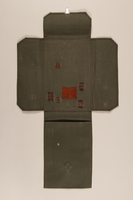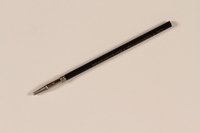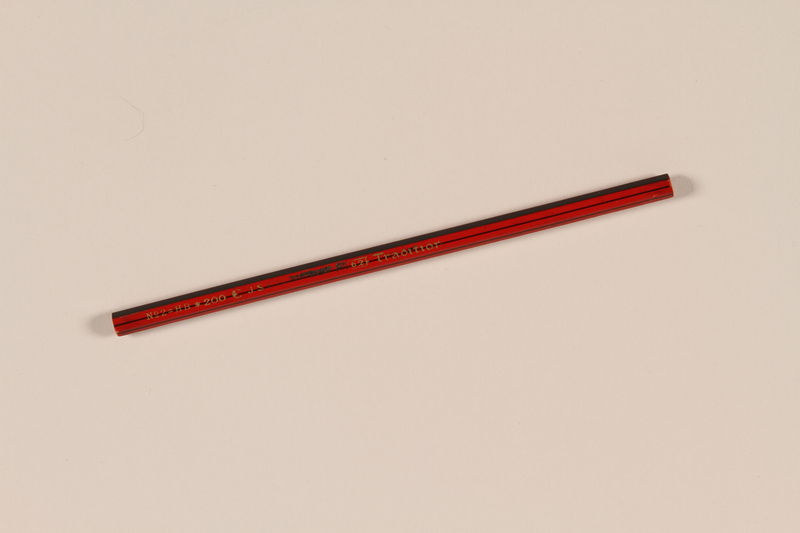Overview
- Brief Narrative
- Staedtler pencil for recording measurements, from a set of anthropometry instruments used as part of eugenics studies conducted in Nazi-controlled Germany from 1933 to 1945. Anthropometry is a branch of Anthropology that focuses on how to systematically identify and classify a range of physical characteristics found within different populations of people. This methodological approach was well-suited to the rising emphasis on eugenics, often referred to as racial hygiene, in Germany during the 1920s and 1930s. Many supporters linked eugenics to race, and believed that “race mixing,” modern medicine, keeping the “unfit” alive to reproduce, and costly welfare programs hindered natural selection and would lead to the biological “degeneration” of society. These ideas and practices began to inform government policy, and were absorbed into the ideology and platform of the newly formed Nazi Party during the 1920s. Following Hitler’s appointment as Chancellor in January 1933, a politically extreme, antisemitic variation of eugenics shaped Nazi policies and permeated German society and institutions. These policies touted the “Nordic race” as its eugenic ideal, and made efforts to exclude anyone deemed hereditarily “less valuable” or “racially foreign,” including Jews, “Slavs, Roma (gypsies), and blacks.” Racial hygiene studies assigned individuals to state-defined races, ranked from “superior” to “inferior,” based on family genealogies, anthropometric measurements, and intelligence tests. Many German physicians and scientists, who had supported racial hygiene ideas before 1933, embraced the Nazi emphasis on biology and heredity, in order to take advantage of new career opportunities and additional funding for research.
- Date
-
use:
approximately 1933-1945
manufacture: after 1900-1945
- Geography
-
use:
Germany
manufacture: Nuremberg (Germany)
- Credit Line
- United States Holocaust Memorial Museum Collection, Gift of the Institut für Humangenetik der Universität Göttingen
- Markings
- side, engraved, in-filled, gold paint : No 2 = HB * 200 (crescent moon logo) J. S. STAED(TLER?) 1662 Tradition
- Contributor
-
Manufacturer:
Staedtler Mars GmbH & Co.
Physical Details
- Classification
-
Office Equipment and Supplies
- Category
-
Writing materials
- Object Type
-
Pencils (lcsh)
- Genre/Form
- Writing Materials.
- Physical Description
- Thin, wooden, six-sided, unsharpened pencil with a cylindrical, gray graphite core and flat, unpainted ends. The exterior is painted a glossy red with a narrow, full-length black stripe along the center of five of the six flat sides. The sixth side is painted black. On the face adjacent to the black side, the manufacturing information is debossed over the thin stripe, and partially filled-in with gold colored paint. Portions of the gold-paint have worn away and black accretions fill in some of the text. The pencil is part of a set of anthropological tools, including spreading (.1.1) and sliding (.1.2) calipers and a grease pencil (.1.3), all stored in a carrying case (.1).
- Dimensions
- overall: Height: 6.875 inches (17.463 cm) | Diameter: 0.250 inches (0.635 cm)
- Materials
- overall : wood, graphite, paint
Rights & Restrictions
- Conditions on Access
- No restrictions on access
- Conditions on Use
- No restrictions on use
Keywords & Subjects
- Topical Term
- Eugenics--Germany--History--20th century. Eugenics--History. National socialism and medicine. Science and state--Germany. Human experimentation in medicine--Germany--History--20th century. National socialism and science--Germany. Anthropometry--Germany. Physicians--Germany. Racism--Germany--History--20th century. Genetics.
- Geographic Name
- Germany. Nuremberg (Germany)
Administrative Notes
- Legal Status
- Permanent Collection
- Provenance
- The pencil was donated to the United States Holocaust Memorial Museum in 1990 by the the Institut für Humangenetik der Universität Göttingen.
- Record last modified:
- 2023-05-24 13:55:32
- This page:
- https://collections.ushmm.org/search/catalog/irn3376
Also in Institut für Humangenetik der Universität Göttingen collection
The collection consists of a medical case containing two calipers and two pencils used as part of anthropological race studies during the eugenics movement in Germany before the Holocaust.
Date: approximately 1900-1945

Custom carrying case containing anthropometry instruments used in Nazi Germany
Object
Carrying case for a set of anthropometry instruments used to measure body parts as part of eugenics studies conducted in Nazi-controlled Germany from 1933 to 1945. Anthropometry is a branch of Anthropology that focuses on how to systematically identify and classify a range of physical characteristics found within different populations of people. This methodological approach was well-suited to the rising emphasis on eugenics, often referred to as racial hygiene, in Germany during the 1920s and 1930s. Many supporters linked eugenics to race, and believed that “race mixing,” modern medicine, keeping the “unfit” alive to reproduce, and costly welfare programs hindered natural selection and would lead to the biological “degeneration” of society. These ideas and practices began to inform government policy, and were absorbed into the ideology and platform of the newly formed Nazi Party during the 1920s. Following Hitler’s appointment as Chancellor in January 1933, a politically extreme, antisemitic variation of eugenics shaped Nazi policies and permeated German society and institutions. These policies touted the “Nordic race” as its eugenic ideal, and made efforts to exclude anyone deemed hereditarily “less valuable” or “racially foreign,” including Jews, “Slavs, Roma (gypsies), and blacks.” Racial hygiene studies assigned individuals to state-defined races, ranked from “superior” to “inferior,” based on family genealogies, anthropometric measurements, and intelligence tests. Many German physicians and scientists, who had supported racial hygiene ideas before 1933, embraced the Nazi emphasis on biology and heredity, in order to take advantage of new career opportunities and additional funding for research.

Faber dermatograph pencil from a carrying case containing anthropometry instruments used in Nazi Germany
Object
Faber-Castell grease pencil for noting measurements on skin, from a set of anthropometry instruments used as part of eugenics studies conducted in Nazi-controlled Germany from 1933 to 1945. Anthropometry is a branch of Anthropology that focuses on how to systematically identify and classify a range of physical characteristics found within different populations of people. This methodological approach was well-suited to the rising emphasis on eugenics, often referred to as racial hygiene, in Germany during the 1920s and 1930s. Many supporters linked eugenics to race, and believed that “race mixing,” modern medicine, keeping the “unfit” alive to reproduce, and costly welfare programs hindered natural selection and would lead to the biological “degeneration” of society. These ideas and practices began to inform government policy, and were absorbed into the ideology and platform of the newly formed Nazi Party during the 1920s. Following Hitler’s appointment as Chancellor in January 1933, a politically extreme, antisemitic variation of eugenics shaped Nazi policies and permeated German society and institutions. These policies touted the “Nordic race” as its eugenic ideal, and made efforts to exclude anyone deemed hereditarily “less valuable” or “racially foreign,” including Jews, “Slavs, Roma (gypsies), and blacks.” Racial hygiene studies assigned individuals to state-defined races, ranked from “superior” to “inferior,” based on family genealogies, anthropometric measurements, and intelligence tests. Many German physicians and scientists, who had supported racial hygiene ideas before 1933, embraced the Nazi emphasis on biology and heredity, in order to take advantage of new career opportunities and additional funding for research.
Spreading calipers from a carrying case containing anthropometry instruments used in Nazi Germany
Object
Spreading calipers, for measuring heads, from a set of anthropometry instruments used as part of eugenics studies conducted in Nazi-controlled Germany from 1933 to 1945. Anthropometry is a branch of Anthropology that focuses on how to systematically identify and classify a range of physical characteristics found within different populations of people. This methodological approach was well-suited to the rising emphasis on eugenics, often referred to as racial hygiene, in Germany during the 1920s and 1930s. Many supporters linked eugenics to race, and believed that “race mixing,” modern medicine, keeping the “unfit” alive to reproduce, and costly welfare programs hindered natural selection and would lead to the biological “degeneration” of society. These ideas and practices began to inform government policy, and were absorbed into the ideology and platform of the newly formed Nazi Party during the 1920s. Following Hitler’s appointment as Chancellor in January 1933, a politically extreme, antisemitic variation of eugenics shaped Nazi policies and permeated German society and institutions. These policies touted the “Nordic race” as its eugenic ideal, and made efforts to exclude anyone deemed hereditarily “less valuable” or “racially foreign,” including Jews, “Slavs, Roma (gypsies), and blacks.” Racial hygiene studies assigned individuals to state-defined races, ranked from “superior” to “inferior,” based on family genealogies, anthropometric measurements, and intelligence tests. Many German physicians and scientists, who had supported racial hygiene ideas before 1933, embraced the Nazi emphasis on biology and heredity, in order to take advantage of new career opportunities and additional funding for research.
Sliding calipers from a carrying case containing anthropometry instruments used in Nazi Germany
Object
Abawerke sliding calipers for measuring noses and ears, from a set of anthropometry instruments used as part of eugenics studies conducted in Nazi-controlled Germany from 1933 to 1945. Anthropometry is a branch of Anthropology that focuses on how to systematically identify and classify a range of physical characteristics found within different populations of people. This methodological approach was well-suited to the rising emphasis on eugenics, often referred to as racial hygiene, in Germany during the 1920s and 1930s. Many supporters linked eugenics to race, and believed that “race mixing,” modern medicine, keeping the “unfit” alive to reproduce, and costly welfare programs hindered natural selection and would lead to the biological “degeneration” of society. These ideas and practices began to inform government policy, and were absorbed into the ideology and platform of the newly formed Nazi Party during the 1920s. Following Hitler’s appointment as Chancellor in January 1933, a politically extreme, antisemitic variation of eugenics shaped Nazi policies and permeated German society and institutions. These policies touted the “Nordic race” as its eugenic ideal, and made efforts to exclude anyone deemed hereditarily “less valuable” or “racially foreign,” including Jews, “Slavs, Roma (gypsies), and blacks.” Racial hygiene studies assigned individuals to state-defined races, ranked from “superior” to “inferior,” based on family genealogies, anthropometric measurements, and intelligence tests. Many German physicians and scientists, who had supported racial hygiene ideas before 1933, embraced the Nazi emphasis on biology and heredity, in order to take advantage of new career opportunities and additional funding for research.




